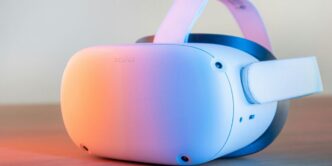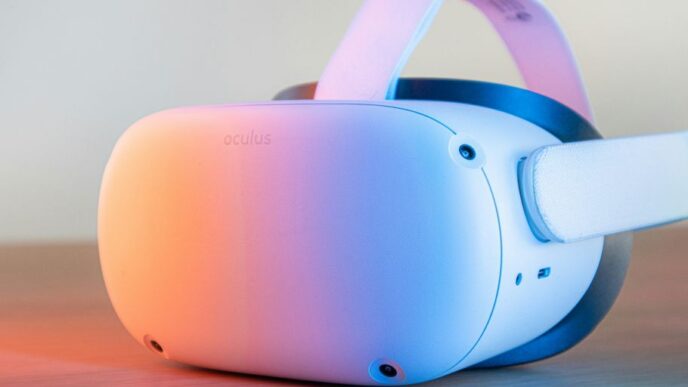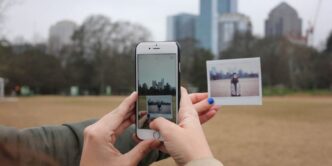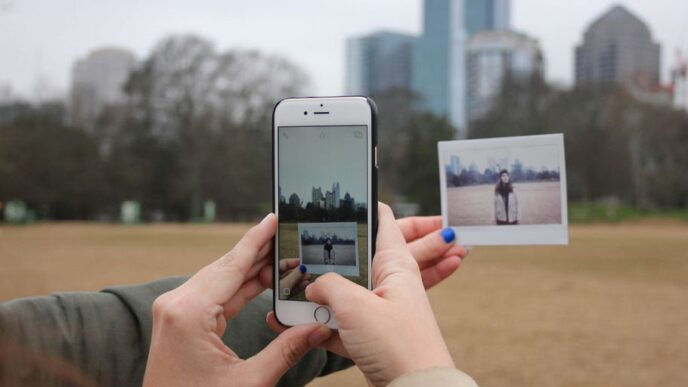Augmented Reality (AR) is changing the way we learn by bringing lessons to life in exciting new ways. It combines digital elements with the real world, allowing students to interact with their subjects like never before. This article explores how AR is being used in classrooms to enhance education across various subjects, from science to language arts. By making learning more engaging and hands-on, AR is helping students understand complex concepts and stay interested in their studies.
Key Takeaways
- Augmented Reality (AR) enhances learning by allowing students to interact with digital objects in the real world.
- AR is different from Virtual Reality (VR) because it adds digital elements to our actual surroundings instead of creating a completely virtual space.
- Using AR can make difficult subjects, like science and math, easier to understand through interactive experiences.
- Successful case studies show that AR can boost student engagement and participation in lessons, making learning more enjoyable.
- Training teachers to use AR tools is crucial for effectively integrating this technology into the classroom.
Understanding Augmented Reality in Education
Definition and Key Concepts
Augmented Reality (AR) is a technology that adds digital elements to the real world. Unlike Virtual Reality (VR), which creates a completely new environment, AR enhances what you see around you. For example, with AR, you can look at a real object and see additional information or images overlaid on it.
Differences Between AR and VR
- Virtual Reality (VR): Immerses users in a completely digital environment.
- Augmented Reality (AR): Adds digital content to the real world.
- Mixed Reality (MR): Combines both AR and VR, allowing interaction with both real and virtual elements.
Historical Development of AR in Education
AR has evolved significantly over the years. Initially, it was used mainly in gaming and entertainment. However, educators began to see its potential for enhancing learning experiences.
| Year | Development | Impact on Education |
|---|---|---|
| 1990 | First AR systems developed | Introduced interactive learning tools |
| 2000 | AR in mobile devices | Made AR accessible to students |
| 2010 | Growth in educational apps | Enhanced engagement and understanding |
AR is changing how students learn by making lessons more interactive and engaging. It allows them to explore concepts in a way that traditional methods cannot.
By integrating AR into classrooms, educators can create a more immersive learning environment that captures students’ attention and enhances their understanding of complex subjects. This technology is paving the way for a new era in education.
Technological Requirements for Implementing AR in Classrooms
Necessary Hardware and Software
To successfully implement augmented reality (AR) in classrooms, schools need specific hardware and software. Here’s a quick list of what’s essential:
- AR-compatible devices: Tablets or smartphones that support AR applications.
- VR headsets: For immersive experiences, headsets like Oculus or ClassVR can be used.
- Software applications: Programs like CoSpaces or Tinkercad help create AR content.
Integration with Existing Educational Tools
Integrating AR with current educational tools can enhance learning. Here are some ways to do this:
- Combine AR with traditional teaching: Use AR to supplement textbooks and lectures.
- Utilize existing platforms: Many schools already use platforms that can incorporate AR features.
- Train teachers: Ensure educators know how to use AR tools effectively.
Overcoming Technological Barriers
While AR offers exciting opportunities, there are challenges to consider. Here are some common barriers and solutions:
- Limited resources: Schools may lack the budget for new technology. Partnering with tech companies can help.
- Training needs: Teachers may need training to use AR tools. Professional development programs can address this.
- Content availability: There may be a lack of AR content for specific subjects. Educators can create or adapt materials to fit their curriculum.
Implementing AR in education can transform learning experiences, making them more engaging and interactive. Schools should focus on the right tools and training to maximize these benefits.
Summary Table of Requirements
| Requirement | Description |
|---|---|
| Hardware | AR-compatible devices, VR headsets |
| Software | AR applications like CoSpaces, Tinkercad |
| Training | Professional development for educators |
Enhancing STEM Education with Augmented Reality
Interactive Science Experiments
Augmented reality (AR) can make science experiments more engaging and interactive. Students can visualize complex concepts like chemical reactions or biological processes in 3D. For example, they can see a virtual model of a human heart and explore its parts in detail. This hands-on approach helps students understand difficult topics better.
Engineering and Design Projects
In engineering classes, AR allows students to create and manipulate 3D models. They can design objects in software like Tinkercad and then use AR to view their creations in the real world. This process not only enhances creativity but also improves technical skills. Here are some benefits of using AR in design projects:
- Real-time feedback on designs
- Ability to visualize projects before building
- Increased collaboration among students
Mathematical Visualizations
Mathematics can be abstract, but AR helps bring numbers to life. Students can interact with geometric shapes and see how they fit together in real space. This method makes learning math more enjoyable and understandable. For instance, they can manipulate a 3D cube to learn about volume and surface area.
AR transforms traditional learning into an exciting adventure. It allows students to explore and experiment in ways that textbooks cannot.
By integrating AR into STEM education, teachers can create a more dynamic and effective learning environment. This technology not only boosts engagement but also helps students grasp complex concepts more easily.
| Benefits of AR in STEM Education | Description |
|---|---|
| Increased Engagement | Students are more interested in learning. |
| Enhanced Understanding | Complex concepts become easier to grasp. |
| Improved Collaboration | Students work together on projects more effectively. |
Augmented Reality for Language and Arts Education
Immersive Language Learning
Augmented Reality (AR) is changing how we learn languages. With tools like lingvist, students can practice vocabulary and grammar in a fun, interactive way. AR apps can create real-life scenarios where learners can practice speaking and listening skills. Here are some benefits of using AR for language learning:
- Real-world practice: Students can engage in conversations in simulated environments.
- Visual aids: AR can display translations and definitions in real-time.
- Gamification: Learning becomes more engaging through games and challenges.
Enhancing Art and Design Classes
In art education, AR allows students to visualize their creations in a new light. They can see their designs in 3D before making them. This technology helps students:
- Experiment freely: Try different colors and shapes without wasting materials.
- Collaborate easily: Work together on projects, even from different locations.
- Receive instant feedback: Get suggestions on their designs through AR tools.
Cultural and Historical Explorations
AR can transport students to different cultures and historical events. For example, students can explore ancient ruins or famous artworks in their classrooms. This method of learning:
- Increases engagement: Students are more interested when they can see and interact with history.
- Enhances understanding: Visualizing historical events helps students grasp complex concepts.
- Promotes empathy: Experiencing different cultures fosters a deeper understanding of diversity.
AR in education opens doors to new experiences, making learning more engaging and effective. It allows students to explore and create in ways that traditional methods cannot match.
Case Studies: Successful AR Implementations in Schools
Media Design in Auckland
In a media design class at Bader Intermediate School in Māngere, Auckland, students use augmented reality alongside 3D printing. This combination allows them to create virtual objects that they can later print in the real world. This hands-on approach encourages creativity and helps students learn technology skills.
- Key Benefits:
- Enhances creativity
- Engages students in the learning process
- Bridges virtual and physical worlds
STEM Labs in Montgomery
Montgomery Public Schools have integrated AR into their STEM labs, leading to increased student engagement. Students can interact with virtual models of complex objects, such as a human heart or a car engine. This interactive learning makes science concepts more tangible and exciting.
| Activity Type | Engagement Level | Student Feedback |
|---|---|---|
| Virtual Science Models | High | Positive |
| Engineering Projects | Very High | Enthusiastic |
| Interactive Lessons | High | Engaging |
Historical Explorations in Spain
At Colegio Escolapios Soria in Spain, students have enjoyed using AR to explore historical concepts. For example, they can hold a virtual model of a volcano, making history lessons more engaging and memorable. This method has shown to significantly boost student interest in learning.
AR transforms learning experiences, making them more interactive and enjoyable for students.
In summary, these case studies illustrate how AR can enhance education by making learning more engaging and interactive. Schools that adopt this technology are seeing positive results in student participation and understanding.
Impact of Augmented Reality on Student Engagement
Increased Participation and Interest
The use of augmented reality (AR) in classrooms has shown a significant boost in student participation. When students interact with AR, they become more involved in their lessons. Here are some key points:
- Hands-on Learning: Students can manipulate virtual objects, making learning more interactive.
- Excitement for Lessons: The novelty of AR tools keeps students eager to learn.
- Variety of Subjects: AR can be applied across different subjects, enhancing engagement in all areas.
Improved Retention of Information
Research indicates that students retain information better when they engage with AR. This is because:
- Visual Learning: AR provides visual representations of complex concepts, making them easier to understand.
- Active Participation: Students are more likely to remember what they actively engage with.
- Real-World Connections: AR helps students relate lessons to real-world scenarios, reinforcing their learning.
Student Testimonials and Feedback
Feedback from students highlights the positive impact of AR on their learning experiences. Many express:
- Enjoyment: Students find lessons more fun and engaging.
- Curiosity: AR sparks curiosity, encouraging students to explore topics further.
- Collaboration: Working with AR often involves teamwork, enhancing social skills.
The integration of AR in education transforms traditional learning into an exciting adventure, making students more engaged and eager to learn.
In summary, the impact of augmented reality on student engagement is profound, leading to increased participation, better retention of information, and positive feedback from students. This innovative approach to learning is paving the way for a more interactive and enjoyable educational experience.
Future Prospects of Augmented Reality in Education
Emerging Trends and Innovations
The future of augmented reality (AR) in education looks bright. As technology advances, we can expect:
- Increased user adoption: Statista predicts AR will reach 1.7 billion users by 2024.
- Integration with AI: Combining AR with artificial intelligence could personalize learning experiences.
- Expansion of content: More educational resources will be available, making AR easier to implement in classrooms.
Potential Challenges and Solutions
While AR offers exciting possibilities, there are challenges to consider:
- Cost of technology: Schools may struggle with funding for AR tools.
- Training for educators: Teachers need proper training to use AR effectively.
- Access to devices: Not all students have access to AR-capable devices.
To address these issues, schools can seek grants, provide professional development, and explore partnerships with tech companies.
Long-term Benefits for Students and Educators
The long-term impact of AR in education could be significant:
- Enhanced engagement: Students are likely to be more involved in their learning.
- Improved understanding: AR can help clarify complex concepts through interactive experiences.
- Collaboration opportunities: Students can work together on AR projects, fostering teamwork.
The integration of AR in education is not just a trend; it’s a transformative shift that can redefine how we learn and teach.
By embracing these advancements, educators can create a more dynamic and engaging learning environment for all students.
Augmented Reality Applications for Homework and Extracurricular Activities
Interactive Homework Assignments
Augmented Reality (AR) can make homework more engaging and fun. Instead of traditional worksheets, teachers can assign AR-enabled tasks that allow students to explore topics in a new way. For example:
- Scan and Learn: Students can scan their homework sheets to access additional resources or hints.
- Virtual Field Trips: Assignments can include virtual tours of historical sites or scientific phenomena.
- Creative Projects: Students can create AR presentations that showcase their understanding of a topic.
AR in After-School Programs
After-school activities can also benefit from AR technology. Here are some ways AR can be integrated:
- Art and Design: Students can use AR to visualize their designs in real-world settings.
- Science Clubs: AR can help students conduct virtual experiments safely.
- Coding and Robotics: AR can enhance learning in coding by allowing students to see their code come to life.
Parental Involvement and Support
AR can also encourage parents to get involved in their children’s learning. Here’s how:
- Shared Experiences: Parents can join their kids in AR activities, making learning a family affair.
- Progress Tracking: AR apps can provide parents with insights into their child’s progress and areas for improvement.
- Resource Sharing: Parents can access AR resources to help their children with homework.
AR transforms traditional homework into exciting adventures, making learning a shared journey for students and their families.
By integrating AR into homework and extracurricular activities, educators can create a more immersive and interactive learning environment that keeps students engaged and motivated.
Training Educators to Use Augmented Reality

Professional Development Programs
To effectively integrate augmented reality (AR) into classrooms, educators need proper training. Here are some key components of professional development programs:
- Workshops focusing on AR tools and applications.
- Online courses that provide flexible learning options.
- Collaborative sessions where teachers can share experiences and strategies.
Hands-on Workshops and Seminars
Hands-on workshops are essential for teachers to gain practical experience with AR. These sessions can include:
- Interactive demonstrations of AR applications.
- Group activities that allow teachers to create their own AR content.
- Feedback sessions to discuss challenges and successes.
Online Resources and Communities
Educators can benefit from various online resources and communities that support AR integration:
- Webinars featuring experts in AR education.
- Forums for teachers to ask questions and share ideas.
- Resource libraries with lesson plans and AR content.
Training in AR is crucial for educators to enhance their teaching methods and engage students effectively.
By focusing on these areas, schools can ensure that teachers are well-equipped to use AR technology, ultimately leading to a more engaging and effective learning environment. The latest technology revolutions in education are paving the way for innovative teaching methods that can transform traditional classrooms into interactive learning spaces.
Augmented Reality Content Creation and Customization
Developing AR Educational Materials
Creating effective AR educational materials involves several key steps:
- Identify Learning Objectives: Determine what concepts or skills you want students to learn.
- Choose the Right Technology: Select AR tools and platforms that fit your needs, such as Metaverse or other AR applications.
- Design Interactive Content: Develop engaging and interactive experiences that enhance understanding, like 3D models or simulations.
Collaborative Content Creation
Collaboration is essential in developing AR content. Here are some ways to foster teamwork:
- Involve Students: Encourage students to contribute ideas and feedback during the content creation process.
- Partner with Educators: Work with other teachers to share resources and best practices.
- Utilize Online Communities: Join forums and groups focused on AR in education to exchange knowledge and experiences.
Adapting Content for Different Learning Styles
To ensure all students benefit from AR experiences, consider these strategies:
- Visual Learners: Use vibrant graphics and animations to capture their attention.
- Auditory Learners: Incorporate sound effects and voiceovers to explain concepts.
- Kinesthetic Learners: Design hands-on activities that allow students to interact with the AR content physically.
AR is changing how we create and customize educational content, making learning more engaging and effective.
By focusing on these areas, educators can create AR content that not only meets educational standards but also captivates students’ interest, leading to a more immersive learning experience.
Evaluating the Effectiveness of Augmented Reality in Education
Assessment Methods and Metrics
To understand how well augmented reality (AR) works in education, we need to look at different ways to measure its impact. Here are some common methods:
- Surveys: Collect feedback from students and teachers about their experiences with AR.
- Test Scores: Compare grades before and after using AR tools in the classroom.
- Engagement Levels: Observe how actively students participate during AR lessons.
Comparative Studies with Traditional Methods
Research shows that AR can be more effective than traditional teaching methods. Here’s a quick comparison:
| Method | Engagement Level | Retention Rate | Student Satisfaction |
|---|---|---|---|
| Traditional Teaching | Low | 50% | 60% |
| Augmented Reality | High | 80% | 90% |
AR significantly boosts student engagement and satisfaction.
This shows that students are more interested and remember what they learn better when using AR.
Feedback from Educators and Students
Many teachers and students have shared their thoughts on using AR in classrooms. Here are some key points:
- Increased Interest: Students find lessons more exciting with AR.
- Better Understanding: Complex topics become easier to grasp.
- More Interaction: AR encourages students to work together and discuss ideas.
Using AR in education has transformed how we teach. It makes learning fun and helps students understand better.
A Teacher’s Perspective
In conclusion, evaluating the effectiveness of AR in education shows promising results. It enhances learning experiences, making them more engaging and effective for students.
Conclusion
In conclusion, augmented reality (AR) is changing how we learn in schools. It makes lessons more exciting and helps students understand tough ideas by letting them see and touch things in a new way. With AR, students can explore everything from the solar system to tiny atoms right in their classrooms. This technology not only grabs their attention but also encourages them to participate more in their learning. As schools continue to adopt AR, the future looks bright for students and teachers alike. By using AR, we can create a more interactive and fun learning environment that prepares students for the challenges ahead.
Frequently Asked Questions
What is augmented reality (AR) in education?
Augmented reality (AR) in education adds digital elements to the real world, making learning more interactive. For example, students can see 3D models of planets while studying in class.
How is AR different from virtual reality (VR)?
AR enhances the real world with digital content, while VR creates a completely virtual environment. In AR, you can see both real and virtual objects together.
What do schools need to use AR?
To use AR in classrooms, schools typically need devices like tablets or smartphones, along with AR apps or software.
Can AR help with science experiments?
Yes! AR can make science experiments more exciting by allowing students to interact with virtual models of molecules or planets.
How can AR be used in language learning?
AR can create immersive experiences for language learners, like virtual conversations with characters or exploring cultural sites.
Are there any successful examples of AR in schools?
Absolutely! Schools in places like Auckland and Montgomery have implemented AR in media design and STEM labs, leading to increased student engagement.
What are the benefits of using AR in education?
Using AR can boost student interest, help with understanding complex topics, and make learning more hands-on and fun.
How can teachers learn to use AR in their classrooms?
Teachers can attend workshops, take online courses, or join communities to learn how to effectively use AR technology in their teaching.













